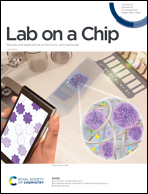Development of elastic artificial vessels with a digital pulse flow system to investigate the risk of restenosis and vasospasm†‡
Abstract
The postoperative risk of stenosis is a complex issue, with risk factors including the status of human umbilical vein endothelial cells, the shear stress of dynamic blood flow, and blood physiology. Current research would benefit from in vitro models that can mimic the microenvironment of living vessels, to study the response of endothelial cells to stent placement. In this study, we constructed a digital pulse flow system based on a group of programmable solenoid valves, to mimic dynamic blood flows in the left coronary artery. Elastic artificial vessels, with internally cultured endothelial cells, were used to simulate vessel function and physiology. Based on this novel platform, we systematically explored cell proliferation and function in artificial vessels implanted with bare metal stents or drug-eluting stents, using unstented vessels as controls, under static and pulse flow conditions. The results indicate that the natural shear stresses of dynamic blood flow actually benefit endothelial cell attachment and proliferation. And drug-eluting stents showed stronger inhibition of cell proliferation than bare metal stents, but had a more negative effect on the synthesis of nitric oxide synthase (NOS), suggesting that drug elution might reduce the postoperative risk of restenosis, while increasing the risk of vasospasm. The results suggest that stent evaluation should include both the risk of restenosis and the effect on endothelial cells. Our simulation establishes a realistic in vitro model for pathological studies of restenosis and vasospasm, shows potential for evaluation of new stent designs, and could help develop individualised therapies for patients with atherosclerosis.



 Please wait while we load your content...
Please wait while we load your content...